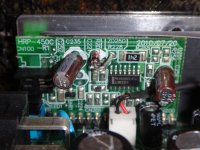I have several of these power supplies in my junk pile, so I would like to do the "R33" type mod to drop the current, as described here:
http://www.recumbents.com/WISIL/e-bent/meanwell/default.htm
I've spent a while looking at similar conversions, but have not found info for this particular model (very little info about the HRP series). If I get it done, I would be happy to do a writeup for the wiki. Can anyone direct me to a link to someone hacking something very close, or a nice writeup for how to find the relevant resistors on an unknown power supply? I understand the concept of using a pot to alter the voltage divider, but hacking without a schematic is a stretch for me.
They seem to be nice supplies. They have built in over-current protection, so they should be hackable.

I plan to use 2 in series to bulk charge 12s 16Ahr Multistars. The supplies put out much more current than I need (18.8A), but they are what I have in the pile, so I'd like to use them.
The supplies also have voltage correction. I think this is managed by the daughter board shown below. Not sure if current control is managed on the same board.

Thank you.
Link to datasheet:
http://www.mouser.com/ds/2/260/HRP-450-SPEC-806168.pdf
The daughter board is located at the circled area.
http://www.recumbents.com/WISIL/e-bent/meanwell/default.htm
I've spent a while looking at similar conversions, but have not found info for this particular model (very little info about the HRP series). If I get it done, I would be happy to do a writeup for the wiki. Can anyone direct me to a link to someone hacking something very close, or a nice writeup for how to find the relevant resistors on an unknown power supply? I understand the concept of using a pot to alter the voltage divider, but hacking without a schematic is a stretch for me.
They seem to be nice supplies. They have built in over-current protection, so they should be hackable.

I plan to use 2 in series to bulk charge 12s 16Ahr Multistars. The supplies put out much more current than I need (18.8A), but they are what I have in the pile, so I'd like to use them.
The supplies also have voltage correction. I think this is managed by the daughter board shown below. Not sure if current control is managed on the same board.

Thank you.
Link to datasheet:
http://www.mouser.com/ds/2/260/HRP-450-SPEC-806168.pdf
The daughter board is located at the circled area.

